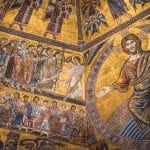 Travel
Travel  Travel
Travel  Movies and TV
Movies and TV 10 Actors Hidden in Your Favorite Movies
 Our World
Our World 10 Science Facts That Will Change How You Look at the World
 Pop Culture
Pop Culture 10 Incredible Female Comic Book Artists
 Crime
Crime 10 Terrifying Serial Killers from Centuries Ago
 Technology
Technology 10 Hilariously Over-Engineered Solutions to Simple Problems
 Miscellaneous
Miscellaneous 10 Ironic News Stories Straight out of an Alanis Morissette Song
 Politics
Politics 10 Lesser-Known Far-Right Groups of the 21st Century
 History
History Ten Revealing Facts about Daily Domestic Life in the Old West
 Weird Stuff
Weird Stuff 10 Everyday Products Surprisingly Made by Inmates
 Travel
Travel 10 Natural Rock Formations That Will Make You Do a Double Take
 Movies and TV
Movies and TV 10 Actors Hidden in Your Favorite Movies
 Our World
Our World 10 Science Facts That Will Change How You Look at the World
Who's Behind Listverse?

Jamie Frater
Head Editor
Jamie founded Listverse due to an insatiable desire to share fascinating, obscure, and bizarre facts. He has been a guest speaker on numerous national radio and television stations and is a five time published author.
More About Us Pop Culture
Pop Culture 10 Incredible Female Comic Book Artists
 Crime
Crime 10 Terrifying Serial Killers from Centuries Ago
 Technology
Technology 10 Hilariously Over-Engineered Solutions to Simple Problems
 Miscellaneous
Miscellaneous 10 Ironic News Stories Straight out of an Alanis Morissette Song
 Politics
Politics 10 Lesser-Known Far-Right Groups of the 21st Century
 History
History Ten Revealing Facts about Daily Domestic Life in the Old West
 Weird Stuff
Weird Stuff 10 Everyday Products Surprisingly Made by Inmates
10 Biggest Turnarounds by the Catholic Church
“Rome never changes.” The Roman Catholic Church affirms that it does not change its doctrines. Critics disagree, pointing out how the faith of contemporary Catholics differs from what was believed and practiced just 60 years ago. Looking further back in time, we can see that the medieval Church of the imperious Pope Innocent III is significantly different from the 21st-century Church of the humble Pope Francis.
Doctrine has a broad range of meanings. Dogma is a doctrine in its strictest sense—a teaching drawn from divine revelation—and is considered infallible. It must be clearly defined and come from the pope and bishops as a body. Lower-tier doctrines are “common teachings” formulated by free opinion but generally accepted by theologians. They rest on a weaker foundation and can change through evolving in response to deeper understanding and changing historical circumstances.
Below are ten of the Church’s most significant changes, or if you prefer, developments in doctrine or practice. Most will agree that these changes were for the better, except perhaps for the celibacy rule.
Related: 10 Peculiar Questions Decided By Church Councils
10 Married Priests
Catholic priests were not originally celibate. St. Peter, considered the first pope, was married, and in the early Christian centuries, most priests had wives. Anti-sex arguments for celibacy from thinkers like Tertullian and Origen clashed with the pro-marriage ideas of theologians like Clement of Alexandria, who viewed celibacy as unmanly shirking of responsibility. He believed that couples could be well suited to the ministry as partners.
But in a world where philosophers propagated the dualistic dichotomy that matter was corrupt while the spirit was pure, asceticism was extolled as the pinnacle of holiness. The writings of St. Augustine, who considered the allure of a woman as a powerful force in a man’s downfall, furthered the case for an unmarried man of God.
The push for celibacy was jump-started in the fourth century when the Council of Elvira decreed, “Bishops, presbyters, deacons and all other clerics having a position in the ministry are ordered to abstain completely from their wives and not to have children.” However, in 580, Pope Pelagius decreed that married priests should be left alone as long as they did not bequeath their properties to their wives and children.
The Elvira decree was largely ignored in the following centuries. Unmarried clerics were also sexually active, resulting in the rise of abortions and infanticide. Bishop St. Ulrich saw these as the worst excesses of celibacy and urged priests to marry. However, the Augustinian notion that sexual expression is defilement prevailed. In 1139, the Second Lateral Council finally made clerical celibacy mandatory throughout the Church.[1]
9 Usury
The growth of commerce and trade in the High Middle Ages saw the rise of the merchant as a member of a distinct class aside from the traditional nobility, peasantry, and clergy. However, a society unused to a money economy looked down on those who made a living buying, selling, and making more money.
Financial gain through the resale of goods the merchant himself did not produce was considered a form of usury, the charging of interest on loans. As such, the medieval merchants and bankers were parasites and sinners in the eyes of the Church. Clearly, the Church no longer views modern businessmen and bankers in such a light. Even the Vatican now owns a bank, and Catholic institutions invest their money for a return. So, what happened?
From antiquity through medieval times, there was a lack of competitive markets, and opportunities for investment were practically nil. Money could only be exchanged for goods for one’s own use or be hoarded and nothing else. Money was truly a barren and sterile commodity.
To lend it expecting interest from a borrower who would not profit from its use was exploiting someone in need and, therefore, usurious. But as the economy grew, so did areas for investment and gain. To charge interest on someone who had profited from a loan is equitable and prompted a reevaluation of what constitutes usury.
The Church has not changed its definition of usury from the Fifth Lateran Council (1515), “when, from its use, a thing which produces nothing is applied to the acquiring of gain and profit without any work, any expense or any risk.” However, it now acknowledges that in the modern market economy, money in itself possesses true value, and charging interest for its use is not necessarily usury.[2]
8 Slavery
Slavery was taken for granted in the Roman world into which Christianity was born. It was not questioned, but the Church made no distinctions between slaves and freedmen as St. Paul enjoined, “You are all one in Christ Jesus.” Church funds were used to redeem slaves, and one former slave even rose to become Pope Callistus I in the 3rd century.
Slavery gradually disappeared as the Church wielded more power and influence. Even then, slavery—owning another human being—was not considered inherently immoral. The great 13th-century theologian St. Thomas Aquinas justified “natural slavery” when he wrote, “Therefore, all human beings who differ from others as much as the soul does from the body, and as human beings do from irrational animals, are, because of the eminence of reason in them and the deficiency in others, by nature masters of the others.”
Things changed in the 15th century when the New World and other lands were opened up by explorers and conquistadors. The European powers built their colonial empires on the backs of enslaved and suffering natives. Beginning with Eugenius IV in 1435, a succession of popes issued condemnations of the practice. On the other hand, Pope Nicholas V’s 1452 bull Dum Diversas granted Portugal the “full and free permission to search out, capture and subjugate… unbelievers… and to reduce their persons into perpetual servitude.”
In the face of ambivalence from Church leaders—none of whom said that slavery was intrinsically wrong—exploitation of the natives continued. It was not confined to Africa and South America. Before the Civil War, the Jesuits were among the biggest slaveholders in Maryland.
During that war against the Confederacy, in 1863, Pope Gregory XVI condemned the “inhuman traffic” of “blacks or any other kind of persons.” Yet again, his encyclical stopped short of proclaiming slavery itself as an evil and so provided wiggle room for pro-slavery forces. It was up to Pope St. John Paul II to unambiguously and unequivocally define where the Church stood in his 1993 encyclical Veritas Splendor, which finally condemned slavery as intrinsically immoral and inexcusable under any circumstances.[3]
7 Capital Punishment
“An eye for an eye, a tooth for a tooth, a life for a life.” This biblical principle governed the Church’s position on the death penalty for centuries. Church and state were inextricably intertwined ever since Rome turned Christian, and the Church acknowledged the power of the state to execute criminals. More than that, the Church also had an equal right to turn over heretics to the secular authorities to be put to death.
“If the criminals who slander the state are sentenced to death… there is even more reason to condemn to death those who offend Christ… because it is much more serious offending the eternal king than to offend the temporal king,” decreed Pope Innocent III in his Vergentis in Senium (1199). St. Thomas Aquinas called the execution of dangerous criminals “laudable and beneficial.”
From the 18th century onward, calls for abolition slowly but steadily grew louder. As social progress accelerated, capital punishment was seen as unnecessary and barbaric, and reforming rather than punishing the criminal became the focus. One country after another abolished the death penalty throughout the 19th and 20th centuries. The Vatican dropped capital punishment in 1969.
In the 1993 Catechism, the Church recognized the right of the state to implement the death penalty only “in cases of extreme gravity,” which were so rare as to be “non-existent.” It became a matter of self-defense rather than punishment. But St. John Paul also said that authorities can now render a criminal harmless “without depriving him definitively of the possibility of redemption” (Evangelium Vitae, 56).
So in 2018, the Church revised its Catechism once again, this time to declare capital punishment “an attack on the inviolability and dignity of the person” and deemed it “inadmissible” in all cases.[4]
6 Limbo
Heaven for the righteous; Hell for the wicked. But what about unbaptized infants who died before they could be one or the other? Theologians have grappled with this problem from the earliest period. The Greek Fathers were more inclined to take a positive view of baby afterlife, while the Latin Fathers were less so.
For St. Gregory of Nazianzen (d. 389), unbaptized babies “will neither be admitted by the just judge to the glory of Heaven nor condemned to suffer punishment, since though unsealed [by baptism], they are not wicked.” His Latin counterpart, St. Augustine, disagreed that there is such an intermediate place. He consigned the poor babies to Hell for the taint of Original Sin, though enduring only the mildest punishment.
Dissatisfied with this harsh concept, St. Thomas Aquinas returned to the notion of limbo, meaning “border,” as a place for babies who never sinned of their own volition and thus were undeserving of Hell, where they would spend eternity in ignorant bliss, neither experiencing the torments of Hell nor the joys of Beatific Vision in Heaven.
This became the standard teaching and was defended by Pope Pius VI in 1794 against the heretical Jansenists who denied the place “which the faithful generally designate by the name of limbo for children” (Auctorem Fidei). Limbo never became an official doctrine, so Catholics were not required to believe it, nor were they allowed to deny its existence. Through the centuries, however, the Church alluded to it, and theologians taught it. So it became “common doctrine.”
Doubts about limbo lingered, and the future Pope Benedict XVI expressed his in 2005. Two years later, the Church’s International Theological Commission released the document called “The Hope of Salvation for Infants Who Die Without Being Baptised.” This reduced limbo to a theological hypothesis and an “unduly restrictive view of salvation” at that. Catholics can still believe it if they want to, but they are now free to deny it.[5]
5 Galileo
In 1543, Polish astronomer Nicolaus Copernicus published his book On the Revolutions of the Heavenly Spheres, which proposed that the Earth rotates daily on its axis and completes a revolution around the Sun in one year. Copernicus could not definitively prove his heliocentric theory, but Galileo’s observations in the next century using his powerful new telescope were consistent with Copernicanism.
Galileo began to complete Copernicus’s arguments, and in 1615, he was charged with heresy for undermining Scripture, specifically Joshua 10:12-13 which says the Sun goes around the Earth. In 1616, Pope Paul V and the Inquisition judged heliocentrism philosophically false and theologically erroneous. Galileo was ordered to desist from teaching it, and Copernicus’s book was banned.
In 1632, thinking that Paul’s successor, Urban VIII, would be more favorable to his case, Galileo published his Dialogue on the Two Chief World Systems, Ptolemaic and Copernican, putting forth solid arguments for heliocentrism. But he misjudged Urban, and Galileo was tried, found guilty of suspected heresy, and put under house arrest. Later, Galileo was allowed to return to his farmhouse, where he died.
The mounting scientific proofs for heliocentrism in the following centuries made the Church’s position untenable. The bans on Revolutions and Galileo’s Dialogue were lifted in the 18th century. In 1992, in the presence of Pope John Paul II, the Pontifical Academy of Sciences delivered their report that said Galileo’s judges were “incapable of dissociating faith from an age-old cosmology.” After 359 years, the Church finally declared Galileo “not guilty.”[6]
4 Cremation
Christian belief in the resurrection created great reverence for the body as the temple of the Holy Spirit. Even in death, the body was treated with respect. Therefore, burning it and thus preventing it from rising to a new life was unthinkable. For 2,000 years, burial was the only appropriate way to dispose of the body.
But in 1963, the Vatican amended the Code of Canon Law, lifting the ban on cremation. As long as it is not done as part of a pagan ritual or to deny the resurrection, cremation is allowed for Catholics. Reasons for permitting cremation include sanitation concerns, overcrowding in cemeteries, and the expense of traditional burial. The Church, however, still prefers burial as the most ideal way of laying the deceased to rest.
Since then, the Church has issued guidelines to be observed for Catholic cremation. In 2016, it explained that “cremation of the deceased’s body does not affect his or her soul, nor does it prevent God, in his omnipotence, from raising up the deceased’s body to new life.” But Catholics are instructed to put away the ashes in a cemetery plot, not divided, scattered, or kept at home.
“The dead body isn’t the private property of relatives, but rather a son of God who is part of the people of God,” said its author, Cardinal Gerhard Mueller. This raises the question: What happens now to saints whose anatomical parts were divvied up and scattered for veneration across Europe? We don’t know, and the Vatican has no plans to reassemble them in the future.[7]
3 Hell
Dante’s Inferno etched into our minds the popular image of Hell and its torments. St. Augustine taught the physical as well as spiritual reality of its tortures. He actually believed the damned would be like salamanders, which were (mistakenly) thought to live through fire without getting burned.
In the 11th century, St. Anselm of Canterbury justified, in his work fittingly titled Meditations to Arouse Fear, the eternal timespan of torture as deserved punishment for offending an infinite God. St. Thomas Aquinas said that the saved would “enjoy their beatitude more thoroughly and give more abundant thanks” by watching the sufferings of the damned from Heaven. Fire and brimstone preaching reinforced these concepts.
For centuries, it was almost an axiom that “Salvandorum paucitas, damnandorum multitudo” (few saved, many damned), a reference to Matthew 7:13-14. “The number of the damned is incalculable,” said the mystic St. Veronica Giuliani. As late as the 20th century, Fatima visionary Sister Lucia lamented, “Taking into account the behavior of mankind, only a small part of the human race will be saved.”
St. Veronica and Sister Lucia were among many mystics who had visions of Hell. The diary of one such visionary read: “I, Sister Faustina Kowalska, by the order of God, have visited the abyss of Hell so that I might tell souls about it, and testify to its existence…the devils were full of hatred… It is a place of great torture.”
The modern Church places more emphasis on God’s love rather than his wrath. It still teaches the reality of Hell, but it is not the Hell of Augustine and Aquinas. In 1999, Pope St. John Paul II declared, “Rather than a place, Hell indicates the state of those who freely and definitively separate themselves from God, the source of all life and joy.” Neither is it the Hell of the mystics. Theologians like Hans Urs von Balthasar have proposed that everyone, after all, will be saved. Pope Francis shared the same optimism and hope for universal salvation: “I like to think of Hell as empty; I hope it is.”[8]
2 Ecumenism
St. Cyprian of Carthage wrote “extra ecclesiam nulla salus” in the 3rd century—”outside the Church, there is no salvation.” For centuries, the Church treated those outside its communion as schismatics and heretics. For a seemingly trivial spat over adding the word “Filioque” to the Nicene Creed, the pope and the patriarch of the eastern churches excommunicated each other in 1054, precipitating the Great Schism.
The Church launched Crusades against the Muslims in Palestine, and Cathars in southern France burned heretics in the Inquisition. “We declare, say, define, and pronounce that it is absolutely necessary for the salvation of every human creature to be subject to the Roman Pontiff,” asserted Pope Boniface VIII in his 1302 bull Unam Sanctam.
The Christian world broke apart in the Reformation, but beginning in the Enlightenment, the impetus to work together across interdenominational lines increased. In lands where numerous sects existed side by side, cooperation instead of conflict made for more effective evangelism. In the 19th century, this movement toward unity was called “ecumenism” from the Greek oikoumene, “the inhabited world,” recalling Jesus’ prayer, “That they all may be one.. .that the world may believe that thou hast sent me” (John 17:21).
The Catholic Church was absent from the 1910 Missionary Conference in Edinburgh, which marked the beginning of the 20th-century ecumenical movement. Still, it couldn’t fail to be affected by the developments. Before 1962, Church documents still labeled non-Catholics as “schismatics” and “heretics.”
In the meantime, there was a growing consciousness of the Church as the Mystical Body of Christ, where an individual’s desire for salvation, regardless of creed, counts for more than membership in a visible organization. Christians can still be part of the Mystical Body even though they are not on the membership rolls of the Catholic Church. In that watershed year of 1962, Pope John XXIII opened the Second Vatican Council, ushering the Church into the modern world.
Among the sweeping changes, other Christians were now called “separated brothers and sisters” or “brothers and sisters in Christ.” Other sects were acknowledged to have ecclesial, or saving, value. In 1964, Pope Paul VI and Patriarch Athenagoras met in Jerusalem. They made the kiss of peace, healing the schism between East and West.
Respect even for non-Christian religions was dramatized by Pope St. John Paul II when he kissed the Quran presented by an Iraqi delegation in 1999. In a dialogue with Buddhists, Pope Francis said that interreligious cooperation allows people to live peacefully as brothers and sisters,” and it reconciles them “to the environment in which they live.”[9]
1 The Inquisition
Of all the sins of the Church, none is more despicable than the Inquisition. The procedure known as “inquisitio,” from the Latin meaning “interrogation,” was originally a legal means of uncovering evidence in a criminal case. It was first applied against religious dissenters by Pope Gregory IX in 1231 to combat the Cathar and Waldensian heretics of southern France. Pope Innocent IV approved the use of torture in 1252.
In 1478, the Spanish Inquisition, notorious for the public burning of heretics called auto-da-fe, was authorized by Pope Sixtus IV. The Grand Inquisitor Tomas de Torquemada alone boasted 2,000 victims. Due to scant records, no one really knows how many people were executed by the Inquisition. Anti-Catholic propaganda claims a blood-curdling tens of millions.
A more believable number may be several thousand, perhaps 3,000 to 10,000, in the Spanish Inquisition, not counting the additional 100,000 to 125,000 who died in prison as the result of torture. But numbers are irrelevant — the fact that pope after pope approved the torture and killing of human beings is a hideous crime no amount of apologetics can rationalize.
In 1994, Pope St. John Paul II asked his cardinals, “How can we be silent about so many kinds of violence perpetrated in the name of the faith?” He compared the Inquisition and the religious wars to “the crimes of Hitler’s Nazism and Marxist Stalinism.” In 2000, the pope delivered a public prayer for pardon, “valid both for the dramas tied to the Inquisition as well as for the wounds of memory that are the consequence of it.”[10]








